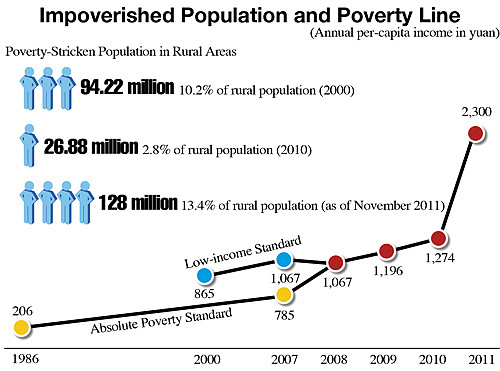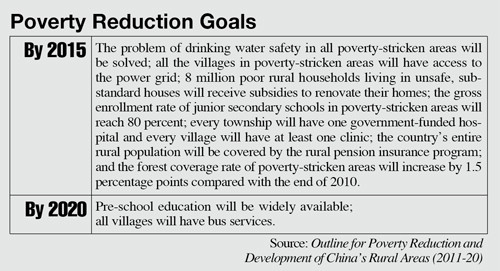|
At a meeting on November 29, Premier Wen Jiabao said local governments in more economically developed regions would be able to set even higher poverty lines. Wen said that the nation's social security funding will prioritize rural regions, especially poverty-stricken areas.
On December 1, the Central Government unveiled its poverty-reduction plan for the next decade, in which it pledged to provide adequate food and clothing for poverty-stricken people while ensuring their access to compulsory education, basic medical services and housing by 2020.
As the third state-level poverty-reduction plan, the Outline for Poverty Reduction and Development of China's Rural Areas (2011-20) says that ensuring sufficient food and clothing for the impoverished and helping them become prosperous will be a government priority over the next decade.
"The widening wealth gaps between urban and rural areas, between different regions and between the rich and the poor in China are worrisome," said Fan Xiaojian, head of the Leading Group Office of Poverty Alleviation and Development under the State Council.
According to him, the average per-capita income of China's urban dwellers was 3.23 times that of rural residents in 2010. The annual per-capita net income of rural residents was 5,919 yuan ($924.8) last year.
"Currently, poverty reduction not only means providing adequate food and clothing for those in need, it also means letting them live with dignity," said Li Xiaoyun, a rural development expert at the Beijing-based Renmin University of China.
"In the past, China faced the challenge of widespread absolute poverty. Right now, its main task is to deal with the yawning wealth gap between the rich and the poor," Li said.
Meanwhile, rural residents who have been lifted out of poverty sometimes fall back into economic hardship once struck by natural disasters or changes to the local economy.
"The difficulty in eliminating poverty, therefore, lies not only in reducing the poverty-stricken population, but also in boosting the ability of impoverished regions to initiate their own development," said Wang Sangui, a professor at the School of Agricultural Economics and Rural Development of the Renmin University of China.
Since 2004, the Central Government has appropriated a total of 3 billion yuan ($468.8 million) in poverty reduction funds for the "Dew Program," which focuses on training members of poor rural families in technical skills and practical agricultural techniques so that they can find better-paying jobs. By the end of 2010, more than 4 million people had received such training, and 80 percent of them found jobs outside agriculture.
The government has been increasing subsidies and scholarships for students from impoverished families at the primary, secondary and tertiary levels of education. From 2001 to 2010, some 42.89 million students graduated from secondary vocational schools, and most of them were from rural families or impoverished urban families.
As part of its poverty reduction strategy the government has also pledged to improve its social security network and make social security "a basic means" to ensure sufficient food and clothing for its rural population.
Established in 2007, China's rural minimum living allowance system had covered 52.14 million poverty-stricken farmers by the end of 2010.
The rural cooperative medical care system, which was launched in 2003, had covered 832 million farmers as of June 2011, or more than 90 percent of China's rural population. The system now allows rural residents to recover as much as 70 percent of their hospitalization fees.
China launched a pilot pension insurance program for its rural population in August 2009 and a total of 199 million Chinese rural residents had joined the program by the end of June. In 2010, the Central Government provided a total subsidy of 11.1 billion yuan ($1.73 billion) for rural residents' pension funds, while local governments supplied 11.6 billion yuan ($1.81 billion). The Central Government pledged to provide sufficient finances to allow the scheme to cover China's entire rural population by 2015.

 | 